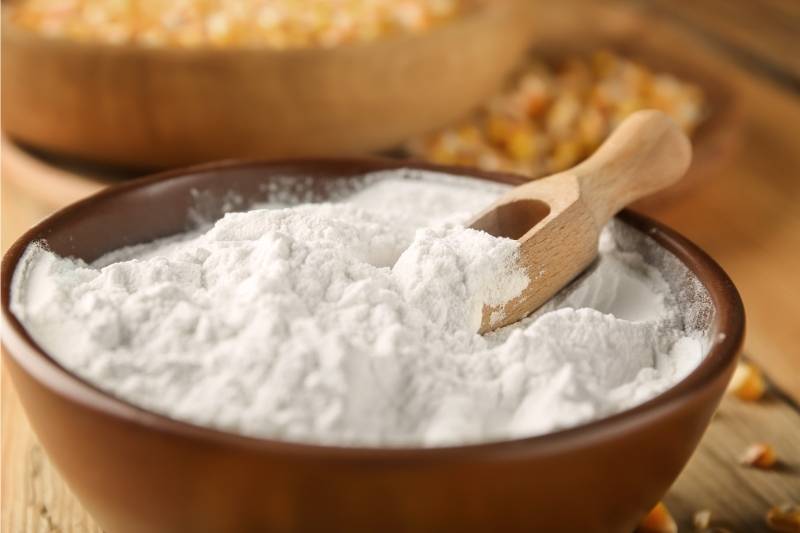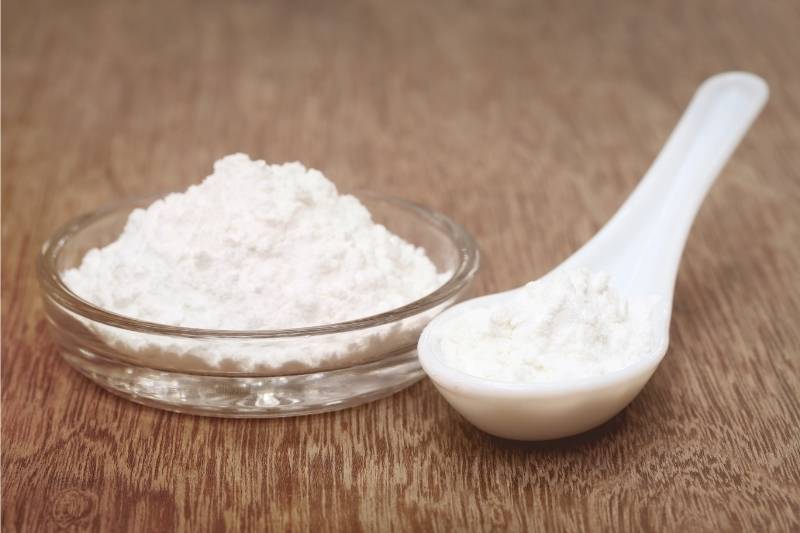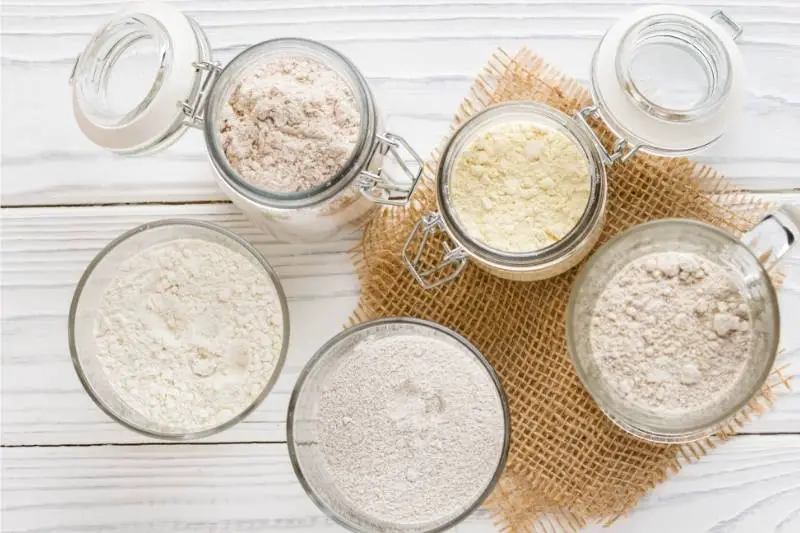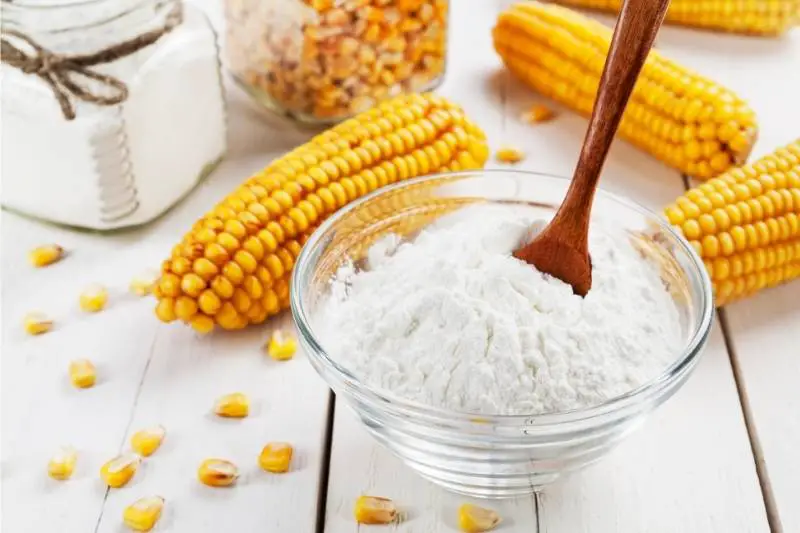This post contains affiliate links.
One of the greatest things that I love about baking is the ability to substitute ingredients in recipes. I can’t begin to explain the number of times I have started baking something only to realize that I’m missing a vital ingredient!
One of the most common ingredients that I run out of first whether it’s for baking or cooking is cornstarch. The first powdery substance that came to mind was baking powder so I decided to initiate my experimentation.
Baking powder is not a substitute for cornstarch. Since cornstarch acts as a thickening agent in recipes, baking powder does not possess the chemical components to replace cornstarch. Adding baking powder will create air bubbles but will not thicken the mixture.
Finding out that baking powder is not a good substitute made me put my thinking cap on. I went on to find the best substitutes for cornstarch that actually worked well! Now when I’m baking and I see that I’m short on cornstarch, I don’t fret because of the endless possibilities on hand.
How is Baking Powder Different From Cornstarch
| Baking Powder | Cornstarch |
|---|---|
| Leavening agent | Thickening agent |
| Causes formation of air bubbles in the mixture | Starch molecules and heat react to thicken the mixture |
| Used to make light and airy desserts | Used to make liquids thicker |
| Made from an acid, base, and a buffer | Made from starch extracted from corn kernels |
When I am in my kitchen baking, I feel like a mad scientist working in my lab to develop all of these different concoctions. There are so many ingredients that undergo chemical reactions to make gorgeous and delicious desserts, I should start wearing a lab coat in the kitchen!
*By the way, you might also want to know If Cornstarch Can Replace Baking Powder. I recently wrote an article about Baking Powder Substitutes That Work, you can check it out here!
Ingredients interact with each other in order to come to a certain outcome. Cornstarch is one of those ingredients that thicken liquids.
To use, you first make a slurry which is just a mixture of even parts of cornstarch and water. This will not thicken your liquid yet because it requires heat. Once you add your cornstarch slurry to your mixture and slowly heat it, it will thicken it to your ideal consistency.

Baking powder, on the other hand, doesn’t possess the same features as cornstarch. As a result, it is actually a very poor thickening agent and should not be used as a substitute.
The best tool that I’ve found to sift my flour is a Battery Operated Electric Flour Sifter For Baking. This wonderful tool automates all of my sifting needs in the kitchen! It has a 4-cup capacity and is washable. What else do you need in an automatic sifter? You can check out this Electric Flour Sifter on Amazon!
The science behind why baking powder can’t be used as a replacement is because it is a leavening agent. Baking powder is used in desserts to give it height through the release of carbon dioxide (like I said, very science-y). The release of carbon dioxide causes air bubbles to form which is what makes desserts light and airy.
Since I was experimenting with baking powder as a substitute for cornstarch, I came to the conclusion very quickly that it’s a bad idea. Adding baking powder will not thicken your mixture. Instead, it will form air bubbles in your liquid without thickening.
*Side Note: You might also want to know how to Store Your Cake Batter The Right Way. I wrote an article about Storing Cake Batter The Right Way, which you can check out here!
Is baking powder and cornstarch the same?

Baking powder and cornstarch are not the same. Baking powder contains both an acid and a base and an intermediate buffer that prevents the acid and base from reacting until the baking step. Cornstarch is made by extracting the starch from corn kernels which is quite starchy.
So let’s be mad scientists for a minute. When an acid and a base are combined together (think adding vinegar to baking soda) you start to see a reaction in the form of fizzing and expansion. In baking, we add baking powder into our cake batters in order to give height to our cakes.
Cornstarch, on the other hand, is made from pure starch that is extracted from corn kernels. When cornstarch is mixed with water and activated with heat, it thickens up a mixture. We commonly see this method used in baking and in cooking (it’s exactly what is used when you make gravy!).
So looking at a side-by-side comparison (see above chart), you’ll notice that baking powder and cornstarch are quite different, regardless of their similar powdery appearance.
*Side Note: If you ever wanted to know The Real Difference Between A Sponge Cake and A Butter Cake. I wrote an article about it that you can find here!
What can be used instead of cornstarch?
To find out what substitutes actually work in place of cornstarch and why baking powder is not a good replacement in recipes, we have to dive into the science behind this magical thickening agent.
Substitutes for Cornstarch
| Cornstarch Substitute | Amount to Replace 1 Tablespoon of Cornstarch |
| Flour | 2 Tablespoons |
| Arrowroot | 1 Tablespoon |
| Tapioca | 2 Tablespoons |
| Potato Starch | 1 Tablespoon |
| Ground Flax Seeds | 2 Teaspoons |
| Rice Flour | 2 Tablespoons |
| Xanthan Gum | 1 Tablespoon |

Use Flour
As a whole, the ideal substitute for cornstarch is flour because it contains starch. The mechanism behind thickening liquids is combining heat and starch. Since both flour and cornstarch contain high starch content, they are the ideal ingredients for thickening liquids.
So why don’t we just use flour for thickening in all our recipes? Well, flour has more components in it besides starch: fiber and protein. This makes it a bit harder to thicken up liquids, which is why, referring to the above table, for every 1 tablespoon of cornstarch, 2 tablespoons of flour is used.
The same methodology should be used when substituting flour for cornstarch (the method below is used to substitute 1 tablespoon of cornstarch in a recipe).
- Prepare a small bowl, a tablespoon, and your flour
- Add 2 tablespoons of flour into the bowl
- Add 2 tablespoons of cold water into the bowl
- Mix well until no clumps remain in the slurry
- Slowly add slurry into the liquid you are thickening
- Heat up the liquid that you are thickening
- Gently mix your mixture until it has thickened
Here are some important tips you should consider about replacing cornstarch with flour:
- When making a slurry, use an equal amount of water with your flour
- Heat is required for thickening your liquid
- Make sure you cook the flour in your mixture for a few minutes longer than you would with cornstarch to remove the raw flavor of flour
- Flour gives your mixture a matte finish while cornstarch gives your mixture a glossy finish
*By the way, if you’re looking for a great Sifter to break down the clumps in your dry ingredients, I found the perfect Baking Sieve Cup Stainless Steel Sifter. This sifter is great because it can sift through large amounts of dry ingredients at a much faster rate than regular handheld sifters. You can check out this Sifter Sieve Cup on Amazon!
Use Arrowroot
Arrowroot powder (also known as arrowroot flour or starch) has been gaining more popularity in the last decade. The starches are derived from the arrowroot plant and processed into a fine powder. Arrowroot powder is a great alternative to cornstarch as one of its main purposes is to act as a thickener in baking and cooking.
Unlike using flour, arrowroot is made of pure starch and can be used in a 1:1 ratio as a replacement for cornstarch. If a recipe calls for 1 tablespoon of cornstarch, you can use a tablespoon of arrowroot powder to replace it.
When it comes to appearances, arrowroot powder mimics the effects of cornstarch by making the texture of your thickened mixture glossy. It gives a beautiful opaque finish, while other less starchy flours give a slightly more matte finish.
Use Tapioca
Like arrowroot, tapioca is derived from a plant called a cassava root. I personally love tapioca thanks to my current obsession with bubble tea. Yes, the squishy bubbles in bubble tea are made from this lovely tapioca powder because of how well it thickens (and it’s so fun to eat!).
The main takeaway from replacing cornstarch with tapioca is that you need to use a 1:2 ratio. If you need 1 tablespoon of cornstarch in a recipe, this is replaced with 2 tablespoons of tapioca powder. In other words, doubling the amount of tapioca will help achieve the proper consistency that you require.
Use Potato Starch
Plant and vegetables that are high in starch values are often broken down and refined into powders. Potato starch is an excellent example of this and is a great substitute for cornstarch.
In recent years, many people have tried swapping out cornstarch for potato starch because it contains fewer carbohydrates. However, this does not affect its ability to properly thicken up a mixture.
Since the properties of potato starch are similar to cornstarch, a standard 1:1 ratio is used for replacement. In other words, 1 tablespoon of cornstarch can be substituted by 1 tablespoon of potato starch.
Use Ground Flaxseed
Are you just as shocked as I am? I think so! The common flax seed that is used in cooking and added into smoothies for its nutritional value, ground flaxseed can actually work as a thickener!
Flaxseed is naturally high in fiber. As a result, when it is introduced to liquids, it can thicken it. However, since ground flaxseed is not as high in starch as cornstarch or even common wheat flour, more of it is required.
To make a slurry to thicken up your mixture, ground flaxseed has to be mixed into water very well. Make sure the ground flaxseed is thoroughly mixed into your water to ensure uniform thickening. For a recipe that calls for 1 tablespoon of cornstarch, mix 2 teaspoons of ground flaxseed with 4 tablespoons of water.
Use Rice Flour
Rice flour is a common staple in many cuisines and has been hitting the shelves of kitchens around the world. Naturally high in starch, rice is refined into flour and is used in many applications of both baking and cooking. It is also great as a thickener because of its lack of color which works for clear liquids.
Because of its similarities with wheat flour, the substitution is a 1:2 ratio. For 1 tablespoon of cornstarch, 2 tablespoons of rice flour can be used.
Use Xanthan Gum
If you are feeling adventurous and definitely more like a mad scientist, xanthan gum is a unique, yet super effective way to go!
“Xanthan gum is produced by fermenting a carbohydrate (a substance that contains sugar) with Xanthomonas campestris bacteria, then processing it.”
Webmd
You can find the full article about xanthan gum here.
In baking, xanthan gum works miracles for gluten-free desserts. Adding this to gluten-free flours helps provide more elasticity to dough and batter as well as provide structure. However, one of the main uses of xanthan gum is to thicken liquids.
It is ideal to use a 1:1 ratio of xanthan gum to replace cornstarch because of how well it acts as a thickener. This means that 1 tablespoon of cornstarch can be substituted with 1 tablespoon of xanthan gum.
How does cornstarch thicken liquids?
Cornstarch is used as a thickening agent in baking and cooking. The key component for cornstarch to work is heat. When mixing cornstarch in water, it will not thicken until it has been thoroughly heated.
When I make a delicious dessert that requires thickening, like my husband’s favorite lemon pie, I turn to cornstarch. I mix cornstarch into my lemon pie filling and heat it until a certain thickness. What I had noticed though, is that if you overmix and agitate it too much, your mixture may actually thin!
I found an article that explains this here.
To summarize, this article states:
“This is due to a process called syneresis (commonly referred to as weeping).”
What is the difference between cornflour and cornstarch?

As a whole, cornstarch is made from only the starchy part of the corn kernel while corn flour is made up of the whole kernel. This includes fiber and protein. Corn flour is not to be mistaken with masa flour which is commonly used to make tortillas.
Corn flour, to an extent, can be referred to as cornmeal because they both come from whole kernels. The difference, however, is how fine it is ground. Cornmeal has a course ground which is great for cornbread but cornmeal is ideal for baking and cooking.
When trying to use cornflour as a substitute for cornstarch, it isn’t the best starch because of how refined it is. Compared to wheat flour or rice flour, cornflour does not contain as much starch to help thicken a mixture without first giving it a tangy and raw taste.
As a result, the only flours that are listed in the table above are rice flour and wheat flour. This is due to their larger quantity of starch.
*By the way, if you are interested in knowing how to get Stuck Parchment Off of Your Cake and how to Prevent It, I recently wrote an article about Removing Stuck Parchment Paper, which you can find here!

